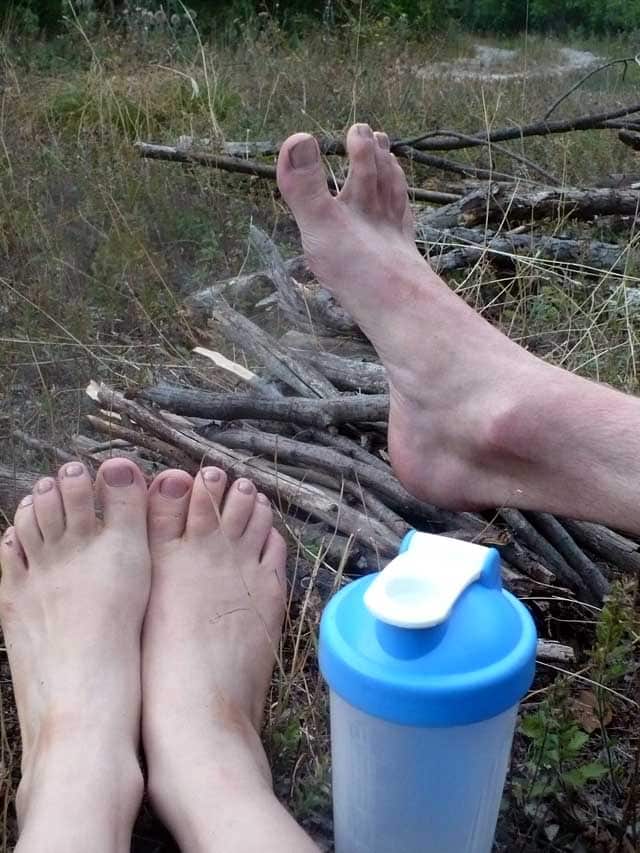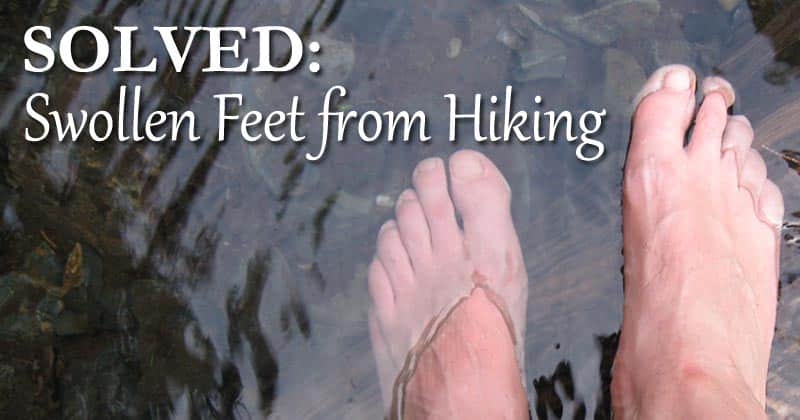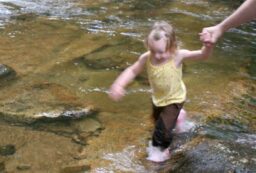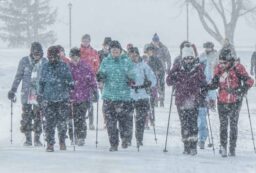One common problem that hikers have is foot swelling. This is bad enough if you are going on a short hike, but even worse if you are thru-hiking. Many thru-hikers find that their boots stop fitting them because of swelling!
There’s no good solution to this once you are halfway through a thru-hike (unless you had the forethought to mail-drop some larger boots, you are stuck wearing thin socks and lacing your boots as loosely as possible!). So, it is good to know how to prevent and treat hiking feet swelling before you set off on your hike.
My Experience with Hiking-Induced Foot Swelling
I’m lucky that I haven’t had my feet or hands swell from hiking. However, my husband has some severe muscle atrophy from polio (got it from a bad batch of vaccines as a baby).
That means he is constantly dealing with foot swelling. Even walking a few kilometers can mean severe swelling. He is a trooper and still goes with me on hikes – but takes a lot of preventative measures to deal with the swelling. So, a lot of the tips about swollen feet come from his 30+ years of experience dealing with this.
What Causes Feet to Swell during/after Hiking?
There are a lot of theories on the web about what exactly causes hiking-induced foot swelling. Note that HANDS can also swell from hiking.
You won’t find much research into hiking or exercise-induced swelling, but here is what the experts and available scientific data have to say.
Cause 1: Peripheral Edema
Edema occurs when excess fluid gets trapped in your body’s tissues. Edema of the hands and feet isn’t just common during hiking. It occurs during all sorts of exercise. The reason why is this:
During exercise, blood flow to your heart, lungs, and muscles increase. This causes your blood vessels to widen (which can cause swelling). On top of this, your body is producing a lot of heat. In order to release this heat, your blood vessels widen. This causes some of your fluids to leak into surrounding tissues.
With the blood vessels so dilated, the body struggles to get the blood back to the heart. It is usually worst in the feet because your body has to fight gravity. However, hands can also swell because they are far from the heart.
How do you know your post-hike swelling is due to peripheral edema? If you elevate your feet or hands, the swelling should go down.
This sort of swelling can be severe. One study found that weight-bearing activity can increase foot volume by up to 8%. (Sources 1, 2, 3, 4, 5)
Cause 2: Hyponatremia
An article in Outside Online about hand swelling during hiking chalked it all up to hyponatremia, a condition where your sodium levels get too low. Here’s the gist of it:
Your body doesn’t suck up water like a sponge. It requires nutrients like sodium in order to absorb water. So, if you drink a lot of water while hiking but don’t get enough sodium, the water will buildup and cause swelling in your body.
Considering that many of us munch on salty snacks like GORP while hiking, I doubt lack of sodium is the problem. If this were the case, you’d also have other symptoms of hyponatremia like:
- Headaches
- Moodiness
- Muscle weakness or cramps
- Confusion
- Nausea or vomiting
That’s not to say you shouldn’t worry about hyponatremia. If you have swelling which isn’t going away when you elevate your feet, hyponatremia might be the culprit. But this still isn’t a good reason to gobble down salty junk food. There are many types of electrolytes aside from sodium! More on this further down…
Cause 3: Overworked Muscles
This is the type of swelling that my husband normally gets. Since his leg/feet muscles are weak, it doesn’t take much for them to get overworked.
The medical term for this is “Delayed Onset Muscle Soreness.” The theory behind DOMS is that your muscles get micro-injuries during exercise. After the exercise, your body gets to work repairing the injuries. The body causes swelling around these areas as a way to protect them.
If you are thru-hiking, your feet are taking a LOT of abuse, so DOMS might be one cause of the swelling. (6, 7)
Cause 4: Too-Tight Gear
Your blood needs to constantly circulate throughout your body. Anything that puts pressure on your body can restrict blood flow, causing it to get trapped.
Too tight boots?
Wearing spandex biker shorts?
Backpack straps digging into your shoulders?
These could result in swelling in your feet or hands. (8, 9)
Solutions for Hiking-Induced Feet/Hand Swelling
(These are all solutions that you can use on the trail while backpacking or thru-hiking!)
1. Prop your feet up
If the swelling is occurring because of peripheral edema, then gravity should make the swelling go away. Put your feet up whenever you stop for a rest and at the end of the day.
If the swelling is really bad, you can even slightly elevate your feet while sleeping. Use your pack or even bring a small log into the tent to serve as a footrest.

Propping our feet up after a long day of hiking
2. Make sure your socks and boots aren’t constricting you:
You should NOT see impressions on your feet from your socks or boots. If you can, this means that they are too tight.
This is tricky because, as your feet swell, the boots can become tighter. This tightness then makes your feet swell more.
One solution is to try lacing your boots differently. The lacing method will change where pressure is on your feet.
Also Read: 15 Ways to Lace Your Hiking Boots
3. Mail-drop yourself new boots:
If you are on a thru-hike and know that your feet will get bigger, then it might be worth it to mail drop yourself new, bigger boots.
Of course, this is risky because you can’t predict with certainty how big your feet will grow on the hike. A member of a hiking forum here recommends this approach: Identify an online source and mail them to yourself when you need them. Only pre-buy boots if you are certain that they are THE shoes you’ll want on your feet for a multi-month hike.
4. Ice your feet!
Applying cold is one of the best ways to reduce feet swelling. You won’t have an ice pack with you on the trail, but you can stick your feet in icy-cold streams.
As per recommendation by his physical therapist, my husband uses this method: ice then heat. So stick your feet in cold water, then wrap them in a towel/sleeping bag/etc. to warm them afterwards. Or you can apply a menthol gel after icing to reduce the swelling.
5. Use trekking poles
I only recently became a trekking pole convert. Why? Because I learned that one of the pros of trekking poles is that they reduce impact on your feet and joints.
One study found that typical hikers transfer TWO TONS per hour onto poles on flat terrain, 28 tons when ascending, and 34 tons when descending!
That’s a lot of impact taken off your feet, which means they are less likely to suffer from injury and swelling. Plus, since trekking poles mean your arms will be moving more, you get better circulation there and hand swelling is less likely.
6. Stop eating junk foods
For many thru-hikers and backpackers, calories-per-ounce is the most important consideration for trail food. This often means bringing junk food (Pringles, anyone?)
But junk food is one of the worst things you can eat for inflammation. Your body needs a full range of NUTRIENTS in addition to calories. Foods high in antioxidants (such as unsweetened dried berries) are particularly good for reducing inflammation.
I’m currently working on a book of Gourmet As Heck dehydrator backpacking food recipes. All of the recipes are healthy and plant-based. Keep an eye out for it!
7. Stay hydrated with electrolytes
My hiking first aid kit (see the checklist here) always contains electrolyte packets. Electrolytes are what your body needs to absorb water. Yes, salt is an electrolyte – but please don’t use this as an excuse to eat salty junk foods. The negatives probably outweigh any benefits you get from the salt.
Other electrolytes include calcium, chloride, magnesium, phosphorus, and potassium.
Instead, eat foods rich in electrolytes such as:
- Bananas
- Cherries
- Raisins
- Coconut
- Dates
- Spinach and other leafy greens
- Packs of tuna or salmon
8. Bring medicated patches or cream
Yes, this will mean carrying extra weight – but some medications can do wonders for inflammation and pain.
My husband uses two types of cream:
- Menthol and anti-inflammatory gel such as Naproxen – good for painful swelling
- Heparin cream – good for non-painful feet swelling
Additionally, a lot of thru-hikers recommend using camphor/menthol patches like Salonpas. The menthol is great for boosting circulation and reduces pain, though it doesn’t directly reduce inflammation. It might work out to be lighter than carrying a gel.

Apparently Tiger Balm is great for swollen feet and joint/muscle pains (the Red Extra Strength Tiger Balm works best). You can apply it to your feet before you start hiking to keep them cool and prevent edema. It also has many other uses which make it worth taking on hikes, like treating bug bites, rashes, coughs, sore throat, and blisters. Plus, mosquitoes hate it!
9. Use compression
For a lot of thru-hikers, the swelling only occurs after they take their boots off (making it hard to get them back on).
Putting on compression socks or using an Ace bandage to wrap feet can prevent fluid from building up in the area. Note that there is controversy as to whether wearing compression socks while hiking actually does any good — it might cut off circulation and make swelling worse! However, there is good anecdotal evidence that putting on compression socks after a hike can reduce swelling.
10. Check your posture
This one is for hiking-induced hand swelling. If you are hunched over while hiking, your backpack will put even more pressure on your shoulders and cut off circulation to your arms and hands. It will be difficult for fluids to return, causing inflammation. So make sure your backpack is on properly and you are standing up straight!
Do your feet swell when hiking? Let us know any tips/tricks you have for dealing with this problem!
Additional resources for this article:
https://www.prevention.com/fitness/g20513849/6-things-to-try-if-exercise-makes-your-hands-or-legs-swell/,
https://www.hiking-for-her.com/swollen-feet-after-hiking.html,
https://backpackinglight.com/forums/topic/85598/
https://blackwoodspress.com/blog/7768/thru-hiking-tips-part-2/
http://graysoncobb.com/hands-swell-hiking/
https://backpackinglight.com/forums/topic/42079/
Title image credit: “poor feet of mine..” (CC BY-NC-SA 2.0) by iwona_kellie













2 Comments
Deepthi
April 22, 2022 at 7:57 amI wish I could show you my feet right now. They look like balloons after trekking for 13 hours… Your blog is very useful. I’m gonna try some techniques.
Bill
July 24, 2022 at 1:39 pmI have applied some ways that I accidentally learned, which is using a hiking pole. When you hold or grip a pole, or stick, the muscles in your hand activate, thus increasing blood flow and preventing hand swelling.